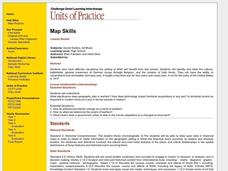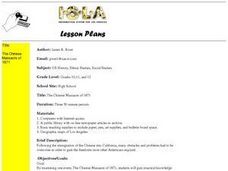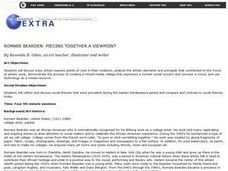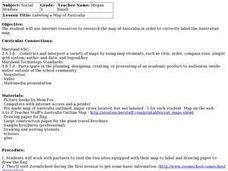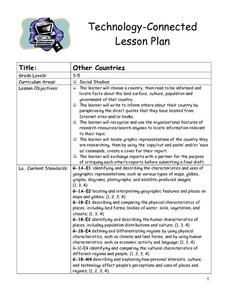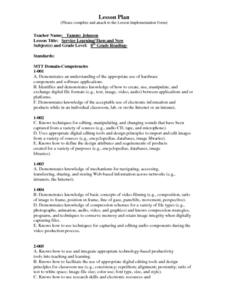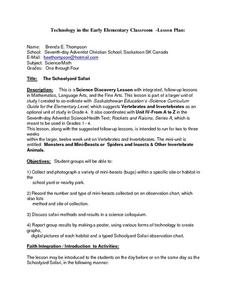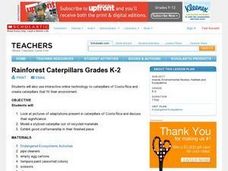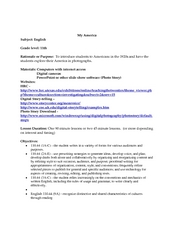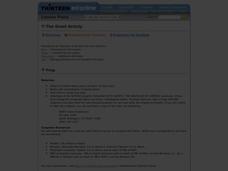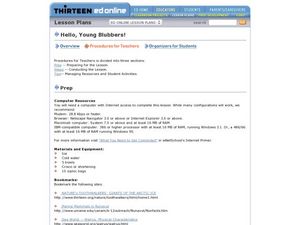Curated OER
The Chinese Massacre of 1871
Students discover the events that led to the migration to California for the Chinese people. They examine the effects that a cultural background has on specific historical events with respect to the establishment of a people.
Curated OER
Map Skills
Students examine the nations, battlefields, troop movement of the Germans through Belgium and the location of both fronts during World War I by creating a map. They visualize the strength of the Germans early in the war.
Curated OER
The Chinese Massacre of 1871
Students investigate the historical Chinese Massacre of 1871. They conduct Internet research, analyze period maps of Los Angeles, read an article, design a timeline, and write a research paper.
Curated OER
Animal Movements
Students discuss the behavior of different animals and how they move. They explore the ways that this helps them live and find food in their environment. They participate in a game that requires them to mimic the ways in which animals move.
Curated OER
Constitutional Issues: Civil Liberties During War
Students discuss democratic ideals and constitutional principles. They decide which side of the issue they are on dealing with the placement of Japanese-Americans in camps during World War II. They examine primary source documents for...
Curated OER
Romare Bearden: Piecing Together A Viewpoint
Students examine the history of Romare Bearden and her artwork. The lesson consists of some virtual field trips and projects. The lesson is designed to be taught as either a social studies or art lesson. The teacher could also teach this...
Curated OER
Labeling a Map of Australia
Third graders label a map of Australia. Using the internet, they research the history and maps of the continent and print a blank map. They review on how to use a compass rose and legend. In groups, they create a brochure to share...
Curated OER
Understanding Europe: A Cultural Mosaic (Theme 1)
Students discuss the cultural similarities and differences found in Northen Europe, Southern Europe, Western Europe, and Eastern Europe and create daily journal entries charting their discoveries. This lesson is the First Part in a Four...
Curated OER
Take Me Out To the Ball Game
Young scholars use a map to graph and locate major league teams of different sports. In groups, they analyze the population data of the United States and compare it with the amount and location of the major league teams. They share their...
Curated OER
Self Portraits
Third graders complete a unit on the writing process that focusses on the self-portraits of Rembrandt and Norman Rockwell. They create their own self-portraits and write autobiographical sketches. They also research the lives of the...
Curated OER
Introduction of Primary Sources
First graders create two personal artifacts to add to a primary source shoebox that represents information about themselves. The first draw a self-portrait then build an artifact from Play-Doh and pipe cleaners to represent something...
Alabama Learning Exchange
Mitosis: Divide to Survive
Learners identify the purpose of cellular mitosis. They work in groups of four to use images of animal and plant cell mitosis to illustrate each step in the mitosis process on their graphic organizer.
Curated OER
Other Countries
Students select a country and conduct research on the culture, population, geography, and government of their country. They conduct research using the Internet and a variety of resource books, and write and publish a report that...
Curated OER
Service Learning/Then and Now
Eighth graders explore service learning projects. They work, in groups, to choose a video project. Students collect information and present it in a storyboard. Next, they use music, video clips, and still pictures to create their video...
Curated OER
The Schoolyard Safari
Students engage in a lesson plan to find out more information about insects. They collect and observe different insects found on school property. They research the insects once they have been classified. Also a video is used to create a...
Curated OER
Working Conditions in America: 1880s versus 2000s
Learners conduct research into the life of Americans and how working conditions have changed over time from the 1880's to modern times. They use primary and secondary resources in order to compile research in order to report the findings...
Curated OER
Immigration For Grades 3-5
Students engage in a lesson that is concerned with the concept of immigration. They conduct research using a variety of resources. Students create a KWL chart to organize the information. The lesson also includes a resource link for the...
Curated OER
Rainforest Caterpillars Grades K-2
Learners are told that after they discuss and examine of rainforest caterpillars, they are going to create their own rainforest caterpillar based on the information they have studied. They are given the habitat scenarios on 3x5 cards.
Curated OER
Peter The Butterfly
Students complete an interdisciplinary unit chronicling the life cycle and movement patterns of the butterfly. Through language arts, mathematics, and science activities, students identify various types of butterflies and document the...
Curated OER
Artifact Analysis Worksheet
In this artifact analysis worksheet, students decipher what type of artifact they have based on a complete list of criteria. Students then answer multiple questions based on their discoveries.
Curated OER
My America
Eleventh graders compare 1920's America to modern America. In this historical perspectives activity, 11th graders research both eras in American history using inquiry skills. As a culminating activity, students create digital slide shows...
Curated OER
The Great Grizzly
Students view video on grizzly bear. In this research lesson students create a list of questions about grizzlies and create a life size poster of an adult grizzly.
Curated OER
Hello, Young Blubbers!
Fifth graders explore walrus and their habitat. In this animal adaptation lesson students complete a hands on activity while in groups and use the Internet for research.
Curated OER
Indian Ocean Explored
Students consider the information presented in the WNET videotape of India: Land of the Tiger/Unknown Seas (Episode 3). In this biology lesson, students view the video and engage in a discussion about the questions posed in the video.

